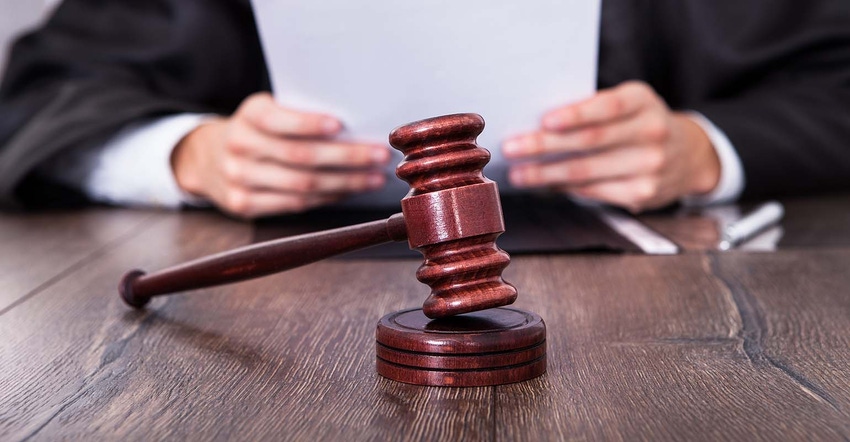
Last Friday’sWall Street Journal published an editorial describing how plaintiffs’ lawyers used junk science to persuade a California jury that a school groundskeeper was ‘exposed’ to glyphosate, and it caused his cancer.
This case and loss will have a huge potential impact on agriculture, if upheld.
The Journal stated “…the problem…is that there’s overwhelming scientific evidence that glyphosate does not cause cancer.” The Journal editorial went on to quote the Journal of National Cancer Institute study which investigated 45,000 licensed pesticide applicators exposed to glyphosate and found “no evidence of an association between glyphosate use and risk of any solid tumors or lymphoid malignancies including non-Hodgkin lymphoma.”
The WSJ editorial even refers to U.S. EPA as concluding glyphosate is safe. One expert claims “There is no known biological mechanism by which glyphosate could cause cancer…”
If this is true and did not get presented to the jury, something is wrong with Monsanto’s legal team.
The World Health Organization’s International Agency for Research on Cancer (IARC) suggests otherwise. IARC surprised many in the scientific community when it concluded glyphosate is “probably carcinogenic.” Subsequent investigations revealed that contrary data had been repeatedly ignored and omitted by IARC.
IARC is the same group that has claimed very hot beverages can cause cancer, among other things. And now this junk science is getting traction in court. Monsanto, now being purchased by Bayer, faces 5,000 similar suits.
Something fishy here
Apparently, the same researcher for IARC also works for plaintiff’s law firm, and even testified as an expert witness in the California jury case.
The plaintiff in the California case is a former school groundskeeper who routinely used Roundup. The lesions which were shown to the jury covered 80% of his body, and he indicated even wearing clothes causes pain. Other stories from the plaintiff’s side of the case indicate Monsanto suppressed evidence which suggested risk associated with the world’s most widely used herbicide that most know by its name, Roundup.
The WSJ did not comment that there was internal correspondence introduced at trial which indicated Monsanto was aware its herbicide was carcinogenic and that Monsanto “…has continuously sought to influence the scientific literature to prevent its internal concerns from reaching the public sphere and to bolster its defenses in products liability actions.”
Plaintiff’s attorney claimed in his argument that “Monsanto has specifically gone out of its way to bully and to fight independent researchers.” Plaintiff’s counsel also presented to the jury, according to one report, internal Monsanto emails which he argued demonstrated “…how the agrichemical company rejected critical research and expert warnings over the years while pursuing and helping to write favorable analyses of their products. They fought science.”
Plaintiff’s counsel used the well-paid activist scientist Christopher Portier. He chaired the IARC evaluation of glyphosate, which has been attacked as deficient. He is now a senior scientist with the Environmental Defense Fund (EDF) and works as an expert witness for law firms who have thousands of clients claiming glyphosate has caused their cancers.
As most readers know, Monsanto began marketing Roundup in 1974. It was a major breakthrough for agriculture and could kill almost every weed without harming humans or the environment. Roundup products are registered in 130 countries and have been approved for use on more than 100 crops. More than 800 scientific studies and reviews and regulatory authorities around the world support the fact that glyphosate does not cause cancer.
Knowing all that, how could Monsanto lose this case?
In a statement released after the trial verdict, Monsanto said glyphosate did not cause the plaintiff’s cancer. The jury believed otherwise and gave the plaintiff $39.2 million to compensate for his injuries and $250 million to punish Monsanto for its conduct. Monsanto will likely appeal or ask the judge to vacate the jury’s decision.
The wrong lawyers
Monsanto was represented by one of the largest Chicago law firms, and its lead trial lawyer has been singled out as one of the best trial lawyers in the United Sates. He is an expert in patent law and white collar defense cases. Agriculture issues do not seem to be part of his practice.
Plaintiff’s lawyer, on the other hand, was a 36-year-old, small town attorney from Orange, Virginia. Background on plaintiff’s attorney indicates he has a practice which focuses on pesticide litigation. Appears he may know and understand agriculture.
There might be a lesson here?
The opinions of the author are not necessarily those of Farm Futures or Farm Progress.
About the Author(s)
You May Also Like




